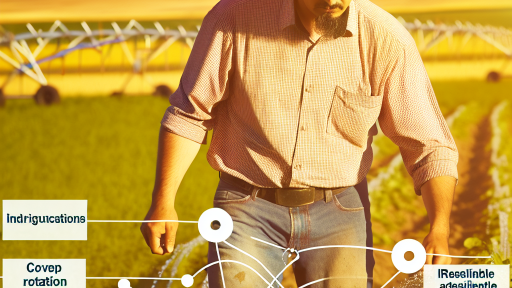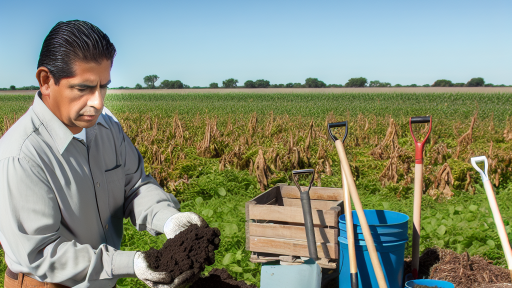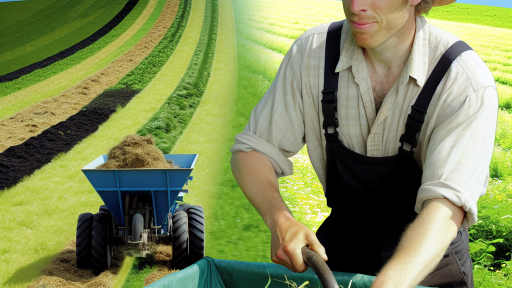Introduction to No-Till Farming and Carbon Sequestration
Understanding No-Till Farming
No-till farming eliminates the need for plowing the soil.
This method preserves soil structure and reduces erosion.
Farmers use specialized equipment to seed directly into the undisturbed soil.
Additionally, no-till practices improve moisture retention.
Overall, this approach enhances soil health over time.
The Role of Carbon Sequestration
Carbon sequestration refers to capturing and storing atmospheric carbon dioxide.
This process occurs naturally in soils and forests.
No-till farming plays a vital role in enhancing carbon sequestration.
When soil is undisturbed, organic matter accumulates more effectively.
Higher organic matter content captures more carbon from the atmosphere.
Benefits of No-Till Farming for Carbon Sequestration
No-till farming provides multiple benefits for carbon sequestration.
- It significantly reduces soil disturbance.
- This practice minimizes carbon emissions from the soil.
- It encourages microbial activity, which helps in carbon storage.
- Furthermore, it leads to a diverse range of crops and cover crops.
Each of these factors contributes to a more resilient ecosystem.
Challenges and Considerations
Despite its benefits, no-till farming also presents challenges.
Some farmers may resist changing traditional methods.
Training and education are crucial for effective implementation.
Transform Your Agribusiness
Unlock your farm's potential with expert advice tailored to your needs. Get actionable steps that drive real results.
Get StartedAdditionally, specific soil types may require careful management.
However, addressing these challenges fosters sustainable practices.
Understanding Carbon Sequestration
Definitions and Importance
Carbon sequestration refers to the process of capturing and storing atmospheric carbon dioxide.
This technique mitigates the effects of climate change.
It involves natural processes as well as technology to remove carbon from the atmosphere.
Importantly, carbon sequestration can occur in various ecosystems.
Soils, forests, and oceans all play significant roles in this dynamic process.
Understanding how carbon sequestering works is crucial for sustainability efforts.
It helps us understand how to reduce greenhouse gases effectively.
This reduction is essential for maintaining a stable climate.
Moreover, enhancing carbon sequestration improves soil health.
Healthy soils support agricultural productivity and biodiversity.
Additionally, carbon storage enhances water retention in soil.
This improvement supports crop resilience against drought.
In summary, carbon sequestration is vital for both environmental and agricultural health.
It presents an opportunity for innovative farming practices.
How No-Till Practices Improve Soil Health
Enhancing Soil Structure
No-till farming maintains soil structure effectively.
This practice prevents soil compaction and erosion.
Healthy soil structure promotes water infiltration.
Additionally, it allows for better air movement through the soil.
Encouraging Microbial Activity
No-till methods foster a diverse range of soil microorganisms.
Microbial communities play a crucial role in nutrient cycling.
These organisms contribute to the breakdown of organic matter.
Consequently, they enhance soil fertility and plant growth.
Showcase Your Farming Business
Publish your professional farming services profile on our blog for a one-time fee of $200 and reach a dedicated audience of farmers and agribusiness owners.
Publish Your ProfileImproving Moisture Retention
No-till practices help retain moisture in the soil.
Soils with good structure hold water more efficiently.
This water retention reduces the need for irrigation.
Farmers can thus save on water resources and expenses.
Increasing Organic Matter
No-till farming encourages the addition of organic materials.
Cover crops and crop residues contribute to soil health.
Increased organic matter enhances soil fertility.
It also aids in carbon sequestration in the soil.
Minimizing Soil Disturbance
No-till soil management limits disturbance to the soil ecosystem.
This approach preserves beneficial soil structures and organisms.
Less disturbance leads to improved nutrient availability.
Hence, crops can access necessary nutrients more efficiently.
See Related Content: Renewable Energy Solutions for Sustainable Farming
The Role of Soil Microorganisms in Carbon Storage
Introduction to Soil Microorganisms
Soyl microorganisms play a crucial role in the ecosystem.
They are responsible for many essential functions in the soil.
These tiny organisms include bacteria, fungi, and actinomycetes.
Each type contributes to different aspects of soil health.
Carbon Sequestration Mechanisms
Microorganisms help in the breakdown of organic matter.
Through this process, they transform carbon into stable forms.
These forms become part of the soil organic matter.
Furthermore, they aid in creating aggregates, which improve soil structure.
Enhancing Soil Health
Healthy soil communities support plant growth effectively.
Microorganisms release nutrients that plants can readily absorb.
This nutrient release enhances photosynthesis and growth.
Additionally, they help in protecting plants from pathogens.
Influence of No-Till Practices
No-till farming preserves the habitat for soil microorganisms.
This practice leads to increased microbial diversity in the soil.
Diverse communities are more resilient and efficient in carbon sequestration.
Moreover, no-till practices limit soil disturbance, maintaining structure.
Case Studies and Research Evidence
Research has demonstrated the effectiveness of no-till farming.
Field studies show increased carbon stocks in no-till systems.
For instance, farms in the Midwest report significant gains in soil carbon.
This evidence underscores the importance of microbial actions in sequestration.
Future Directions for Research
Understanding microbial interactions is vital for future research.
We need to investigate how different practices affect these communities.
Additionally, identifying key microbial species can help optimize carbon sequestration.
Research will enhance our strategies for sustainable agriculture.
Delve into the Subject: Enhancing Soil Health through Carbon Sequestration
Comparison of Carbon Storage in No-Till vs. Conventional Farming
Understanding Carbon Sequestration
Carbon sequestration is the process of capturing and storing atmospheric carbon dioxide.
This process helps in reducing greenhouse gases and combating climate change.
Showcase Your Farming Business
Publish your professional farming services profile on our blog for a one-time fee of $200 and reach a dedicated audience of farmers and agribusiness owners.
Publish Your ProfileNo-till farming plays a significant role in enhancing carbon sequestration in agricultural soils.
Carbon Storage in No-Till Farming
No-till farming preserves the soil structure and enhances organic matter retention.
This practice leads to greater carbon storage in the soil compared to traditional methods.
Research indicates that no-till systems can store up to 30% more carbon over time.
Carbon Storage in Conventional Farming
Conventional farming often involves plowing, which disrupts soil structure.
This disruption can release stored carbon back into the atmosphere.
Moreover, soil erosion in conventional systems further reduces carbon capture capabilities.
Comparative Analysis
In no-till systems, increased root biomass contributes to soil carbon accumulation.
Conversely, conventional practices typically lead to lower soil organic carbon levels over time.
A study conducted by the University of Nebraska found significant carbon loss in conventional farms.
These findings highlight the advantages of embracing no-till practices for carbon storage.
Implications of Sustainable Farming Practices
Adopting no-till farming can be a vital strategy for sustainable agriculture.
This method not only improves soil health but also plays a critical role in climate mitigation.
Transitioning from conventional to no-till practices offers substantial environmental benefits.
You Might Also Like: How Farmers Are Battling Heatwaves and Drought with Innovation

Case Studies: Successful Implementation of No-Till Farming
Introduction to Case Studies
Case studies provide real-life examples of no-till farming benefits.
They illustrate how farmers can effectively implement this technique.
These cases demonstrate positive impacts on carbon sequestration.
Example from Springfield Farms
Springfield Farms successfully adopted no-till practices in 2018.
The farm, located in Ohio, aimed to enhance soil health.
Over five years, the soil organic carbon levels increased by 20%.
This improvement significantly reduced overall greenhouse gas emissions.
Techniques Used
They utilized cover crops to protect and enrich the soil.
Additionally, they applied precision planting techniques.
These methods minimized soil disturbance and preserved moisture.
Outcomes Observed
Increased crop yields were noted over multiple growing seasons.
The quality of their soil improved, leading to more resilient plants.
Moreover, pests were managed naturally, reducing chemical reliance.
Success at Green Acres Ranch
Green Acres Ranch, situated in California, started no-till farming in 2015.
The ranch focused on sustainable practices for its diverse crops.
During a drought year, soil moisture retention improved remarkably.
Implementation Strategies
The ranch implemented crop rotation alongside no-till methods.
They also introduced mulch to protect and nourish the soil.
This approach created a healthier ecosystem for crops.
Measured Benefits
Carbon sequestration rates increased significantly at Green Acres.
Soil fertility improved, yielding nutritious crops consistently.
The ranch reported enhanced biodiversity on their land.
Insights from Maplewood Homestead
Maplewood Homestead has been a pioneer in no-till farming since 2020.
They specialize in organic produce, promoting environmentally friendly practices.
Their efforts produced a 30% reduction in soil erosion.
Showcase Your Farming Business
Publish your professional farming services profile on our blog for a one-time fee of $200 and reach a dedicated audience of farmers and agribusiness owners.
Publish Your ProfileStrategies Employed
Cover cropping, mulching, and minimal tillage were central to their success.
They also integrated agroforestry to enhance soil health.
This system promotes a diverse habitat, beneficial for pest control.
Environmental Impact
Carbon levels in the soil showed continuous improvement over time.
The diverse ecosystem fostered resilience against climate extremes.
Overall, Maplewood Homestead set a benchmark for others.
Discover More: Climate-Smart Agriculture to Combat Greenhouse Gases
Challenges and Barriers to Adopting No-Till Practices
Financial Constraints
One major barrier to no-till adoption is financial constraints.
Many farmers face high initial costs for no-till equipment.
Additionally, they may experience decreased cash flow during the transition period.
These financial pressures can discourage farmers from making necessary investments.
Knowledge and Skill Gaps
A lack of knowledge and skills further complicates no-till adoption.
Many farmers are unfamiliar with no-till techniques and benefits.
This knowledge gap often leads to hesitation in changing traditional practices.
Moreover, training opportunities may be limited in certain areas.
Soil Health Concerns
Some farmers worry about soil health when switching to no-till practices.
They may fear potential issues like compaction and reduced soil aeration.
Such concerns can deter them from transitioning to no-till systems.
Ongoing research and education are crucial to addressing these misconceptions.
Support Systems and Incentives
Adequate support systems and incentives are often lacking.
Many farmers do not have access to financial assistance programs.
Furthermore, technical support from agronomists may be insufficient.
Incentive programs can encourage more farmers to adopt no-till practices.
Climate Variability
Climate variability presents another challenge for farmers.
Changes in weather patterns can affect soil conditions and farm management strategies.
This uncertainty may lead farmers to prioritize short-term stability over long-term practices.
Consequently, they may resist adopting no-till farming methods.
Future Prospects: Innovations in No-Till Farming and Carbon Management
Advancements in Technology
Technology continuously evolves, enhancing no-till farming practices.
Precision agriculture tools enable farmers to optimize soil health.
Drone technology assists in monitoring crop conditions effectively.
These innovations help identify areas needing attention in real-time.
Soil Health Improvements
Healthy soil is vital for carbon sequestration.
Cover crops enrich the soil and improve its organic matter.
This process enhances soil structure and nutrient availability.
Moreover, earthworms and beneficial microbes thrive in no-till systems.
Carbon Credit Markets
Emerging carbon credit markets incentivize sustainable practices.
Farmers can sell carbon credits for improved practices.
This financial opportunity encourages more farmers to adopt no-till methods.
Consequently, no-till farming becomes a viable revenue source.
Research and Education Initiatives
Continuous research enhances understanding of carbon management.
Showcase Your Farming Business
Publish your professional farming services profile on our blog for a one-time fee of $200 and reach a dedicated audience of farmers and agribusiness owners.
Publish Your ProfileOrganizations like the Soil Health Institute promote best practices.
Educational workshops equip farmers with innovative techniques.
This knowledge facilitates the adoption of no-till farming.
Collaboration Among Farmers
Farmers sharing knowledge fosters community growth.
Collective efforts lead to scaling sustainable practices.
Networks provide support and resources for implementing no-till farming.
Ultimately, collaboration enhances long-term viability in agriculture.
Additional Resources
No-Till Farming Improves Soil Health and Mitigates Climate Change …




